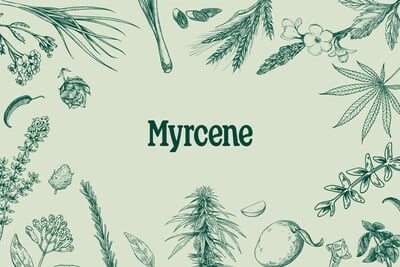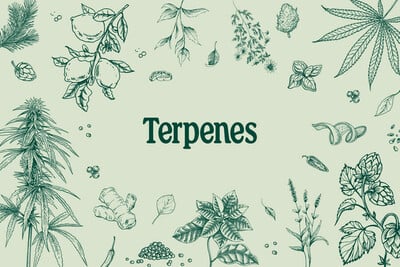.

Humulene: An Earthy and Soothing Cannabis Terpene
Humulene contributes a soothing and relaxing effect to many cannabis cultivars. Influence aside, this aromatic compound also treats users to wood, earth, and spice flavours. Now, researchers are probing this terpene in an effort to unlock its therapeutic potential, testing it against models of inflammation and infection.
Contents:
Humulene doesn’t just add flavours of earth, wood, and spice to certain cannabis strains. The compound also targets the CB1 receptors of the endocannabinoid system—the same network that underpins the cannabis high. Learn everything you need to know about this fascinating compound below, including the latest scientific research.

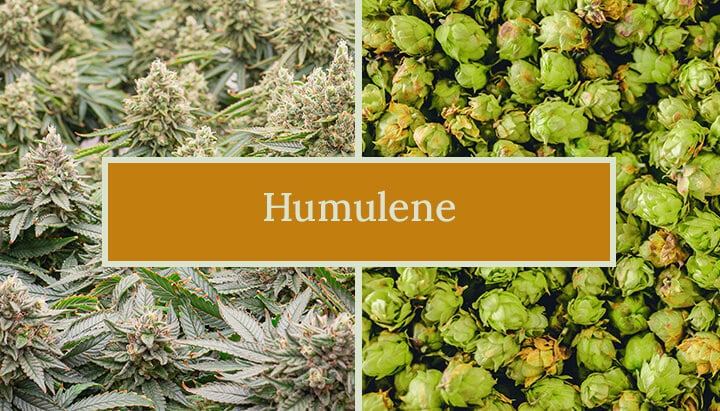
What Are Terpenes, Exactly?
Terpenes are aromatic compounds that underpin the flavours and aromas of different plants and their anatomical parts. These fragrant chemicals are rooted in the unmistakable tastes of mango and apple and the aromas of mint, pine, and orange. Around 30,000 known terpenes exist in nature across several distinct molecular groups. While structurally different, these compounds share the same building blocks—isoprene units.
Isoprene units are building blocks that enable plants to manufacture various constituents, including essential oils, pigments, and hormones. Terpenes are categorised based on the number of isoprene units they contain. Simple monoterpenes such as limonene and myrcene contain just two isoprene units. In contrast, more complex sesquiterpenes, such as humulene beta-caryophyllene, contain three. Elsewhere in nature, large polyterpenes contain over forty isoprene units.
Aside from smelling and tasting, terpenes play an essential role in the health and survival of many plant species, including cannabis.
The Role of Terpenes in Nature
As secondary metabolites, terpenes aren’t directly involved in the growth and reproduction of cannabis plants. You can look at them more like chemical weapons and shields. Weed plants invest resources into creating terpenes to help manage stress and increase their chances of survival. Volatile in nature, terpenes are able to defend plants against a range of pests. Terpenes such as humulene, pinene, and eugenol are directly toxic to some pests, whereas the likes of limonene can repel and deter aphids from laying eggs. Other terpenes act as growth inhibitors and influence the development of certain pest species.
Terpenes also help to shield plants from abiotic or nonliving sources of stress. The production of these phytochemicals offers a line of defence against fluctuations in temperature, drought, and UV radiation from the sun.
Plants also use terpenes to impact their environment. These chemicals act as signalling molecules between plants that enable them to alert each other to predators and pests, giving their neighbours a chance to ramp up the production of more defensive compounds. Certain tree species also emit higher levels of terpenes into the atmosphere, impacting weather patterns.
The Chemistry of Humulene
Cannabis plants produce upwards of 150 unique terpenes. Among these, a handful stand above the rest. These compounds are more valuable to consumers because of their preferred flavours and aromas and have, therefore, received more attention from scientific researchers. Humulene, also known as alpha-humulene, has become particularly popular owing to its pleasant earth aromas and soothing properties.
Humulene, with a chemical formula of C15H24, comprises three isoprene units. It is classified as a sesquiterpene alongside beta-caryophyllene. The additional isoprene unit that sets it apart from monoterpenes makes this molecule larger and more stable, meaning it is less volatile than terpenes such as pinene.
How Is Humulene Extracted?
Humulene has very low water solubility in its natural form. Many manufacturers use steam distillation to extract humulene and other terpenes from plant material. This process uses hot steam to vaporise terpenes before condensing them into a liquid solution. The oily terpenes sit atop the water, making them easier to separate and isolate.
Where to Find Humulene
Humulene occurs in a range of different plants, including:
- Cannabis
- Hops
- Black pepper
- Ginseng
- Basil
- Tobacco
- Sage
- Ginger
In some plants, such as pine trees, sage, and ginger, the terpene occurs in various tissues. However, in the case of cannabis and hops, it’s produced in specialised glands called trichomes. Both cannabis trichomes and the lupulin glands of hops biosynthesis humulene and churn it out (alongside over phytochemicals) as a viscous resin.
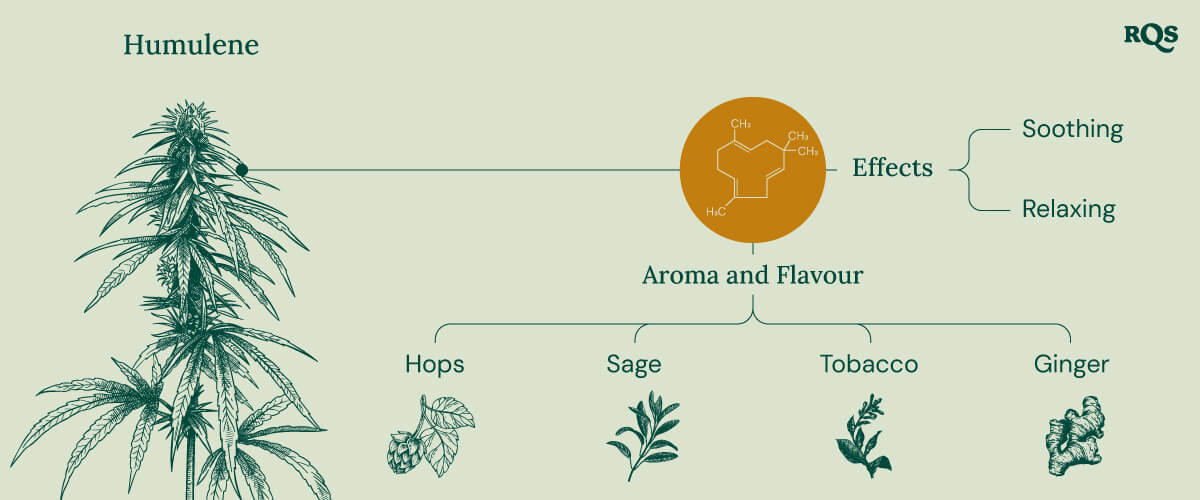
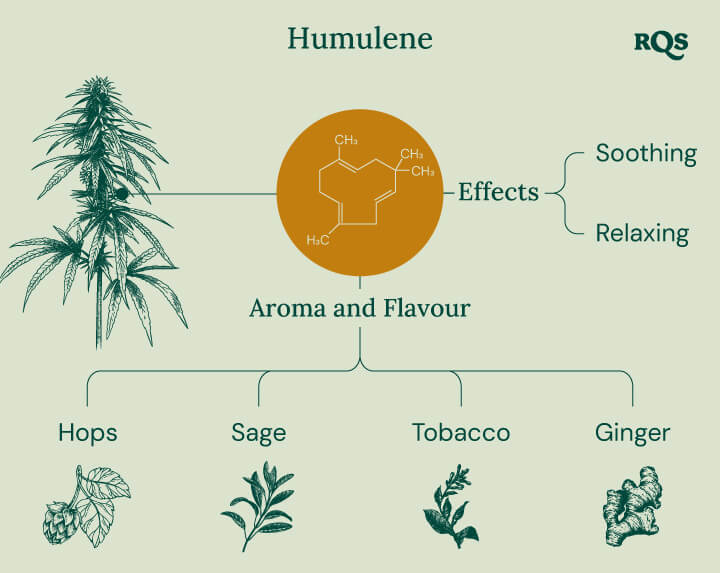
The Aroma and Taste of Humulene Terpene
Humulene features a distinctive flavour and aroma that is popular among many cannabis users. This terpene infuses buds with savoury hints of earth, wood, herbs, spices, and hops. These flavours are apparent when smoking but really stand out during vaporisation. These tastes also make humulene-rich strains preferable to cannabis chefs when cooking up infused savoury dishes.
Humulene Effects: What to Expect
Strains high in humulene vary in their effects depending on other phytochemicals present. Each variety features a complex cocktail of compounds, with humulene playing an important role. Whether a cultivar is high in THC or CBD, humulene adds a soothing and physically relaxing effect.
Humulene: A Look at the Research
While the effects of humulene on the human body remain relatively unknown, a selection of cell and animal studies have revealed its potential mechanisms of action. Check out some of the studies below to see how scientists could use the terpene in the future.
- Cannabimimetic Properties
- Much like beta-caryophyllene, humulene acts as both a terpene and a cannabinoid. Research[1] conducted at the University of Arizona demonstrated that several common cannabis terpenes, including humulene, activate the CB1 receptor of the endocannabinoid system. Because this signalling network impacts so many areas of the body, future research into humulene’s impact could have far-reaching consequences. This research also suggests that humulene synergises with other compounds that affect the endocannabinoid system, including cannabinoids such as THC and CBD.
- Antiproliferative Properties
- A host of studies[2] have examined the effects of humulene on cell models of tumours. While this research remains in the early stages, the authors of a review examining the terpene stated, “Across these studies, α-humulene consistently demonstrated cytotoxic activity against tumour cells..”.
- Antimicrobial Properties
- The results of cellular studies[3] show humulene exhibits promising antimicrobial properties. Researchers have tested the compound against bacteria, including Staphylococcus aureus, where “Formulations with 10% and 20% α-humulene reduced bacterial growth..”. Studies have also pitted the chemical against the fungus Peronophythora litchii, where it “exhibited weak inhibitory effects”.
- Anti-Inflammatory Properties
- Inflammation plays a crucial role in many modern chronic health conditions, leading researchers to hunt for new ways to combat the physiological condition. Many plant compounds, including humulene, show promise in addressing inflammation. An extensive scientific review[4] on the terpene documents studies in both cell and animal models, with results showing humulene’s inhibition of inflammatory markers.
- Antiparasitic Properties
- Researchers from the University of Campinas, Brazil, tested humulene[5] and other sesquiterpenes on the parasite Schistosoma mansoni, a water-borne parasite responsible for Katayama fever. Humulene showed promise in the study, with researchers concluding: “..the present study results contribute to an understanding of alpha-humulene and trans-caryophyllene effect over these targets, contributing for the development of schistosomicidial drugs.
Humulene: A Powerhouse Cannabis Compound
Humulene contributes pleasant earth, wood, and spice flavours to many cannabis strains. On top of this, it also impacts the subjective effects of these varieties, imparting a relaxing and soothing sensation. Ongoing investigations are probing the compound's potential role in various diseases, including bacterial infections, tumours, and parasites. While the research remains far too early to draw any conclusions, we could see humulene gain a lot more focus in medical marijuana programs as more human studies emerge in the future.
- Cannabis sativa terpenes are cannabimimetic https://www.ncbi.nlm.nih.gov
- The Clinical Translation of α-humulene – A Scoping Review https://www.thieme-connect.com
- Specific properties of α-humulene https://www.thieme-connect.com
- Sesquiterpenes evaluation https://www.thieme-connect.com
- Sesquiterpenes evaluation on Schistosoma mansoni: Survival, excretory system and membrane integrity https://www.sciencedirect.com




































